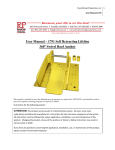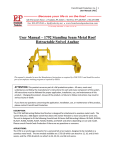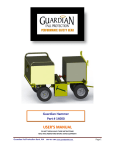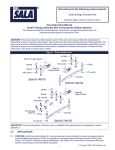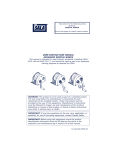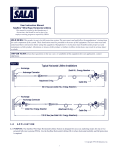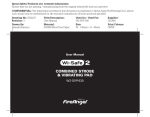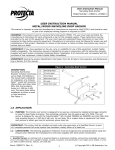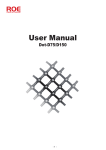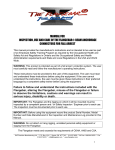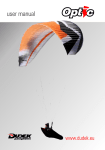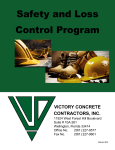Download French Creek 25 ft. Retractable instruction manual
Transcript
User Manual - Self Retracting Lifelines This manual is intended to meet the Manufacturer Instructions as required by ANSI Z359.1 and should be used as part of an employee training program as required by OSHA. Instructions for the following series products: RL 25A SERIES (RL25AG, RL25AS, RL25AT) ATTENTION: This product serves as part of a fall protection system. All users, must read, understand, and follow the manufacturer’s instructions for each and every component of the system. All instructions must be followed for proper application, installation, use, and maintenance of this product. Changing the product, misuse of the product, or failure to follow instructions may result in serious injury or death. If you have any questions concerning the application, installation, use, or maintenance of this product, please contact FrenchCreek Production. DESCRIPTION RL Series retractable lifelines come with a carabiner for anchorage tie off, impact indicating swivel locking snap for harness connection, lengths from 20 – 50 ft, and choice of lifelines from galvanized wire rope, stainless steel wire rope and synthetic rope. 1.0 APPLICATIONS 1.1 PURPOSE: FrenchCreek Production self retracting lifelines are components in personal fall arrest systems (PFAS). They are to be used in situations where worker mobility and fall protection is needed. A. FALL ARREST: This device is used as part of a personal fall arrest system, which includes a FrenchCreek Production full body harness, and a FrenchCreek Production anchorage connector. 1.2 LIMITATIONS: The following application limitations must be considered before using this product: A. CAPACITY: The SRL is for use by a single person with a combined weight (person, clothing, tools, etc.) 310 lbs. maximum. B. FALL CLEARANCE: Proper clearance must be present below the worker to arrest a fall and avoid striking a lower level, obstruction, or the ground. A clear fall path must be present to ensure the retractable lifeline will arrest a fall. 1 C. STANDARD USE: The retractable lifeline will extend and retract the full length of the lifeline while keeping some tension on the line. If a fall occurs, the retractable lifeline will arrest the fall and absorb the energy created during the fall. If a fall occurs at maximum lifeline length, the energy absorber is located externally and will allow for full function during the arrest. Always use a tag line when conditions require. Always allow the lifeline to slowly retract into the housing. Avoid swing falls by always working directly under the anchorage. Never work above the anchorage. Do not use if any part of the system does not pass inspection. Do not service this device. Do not allow lifeline constituent (cable/synthetic rope) to come into contact with anything that will damage the lifeline including sharp, abrasive rough, or high temperature surfaces, welding, heat sources, electrical hazards, or moving machinery. Do not service or lubricate this device. Service to be performed only by FrenchCreek Production or authorized agents. D. ENVIRONMENTAL CONDITIONS: Conditions in the surrounding environments can cause damage and may affect the performance of the product. Use in these environments may require more frequent inspections and service. Such environments may include; chemical hazards, elevated temperatures, electrical hazards (always avoid contact with electrical hazards), corrosive environments, etc. Contact FrenchCreek Production with any questions about corrosive environments. E. TRAINING: This equipment must be installed and used by persons trained in its correct application and use. National standards (ANSI) and federal regulations (OSHA) require training before using this equipment. Refer to all applicable federal, state and local regulations governing the training requirements of this equipment. 2.0 SYSTEM REQUIREMENTS 2.1 PERSONAL FALL ARREST SYSTEM: FrenchCreek retractable lifelines are designed for use with FrenchCreek Production approved components and subsystems only. Other components may be incompatible, which could directly affect the safety and reliability of the entire system. Personal fall arrest components used with this system must meet all applicable OSHA and ANSI requirements. A FrenchCreek anchorage connector and full body harness are recommended components for this retractable lifeline. 2.2 COMPONENT COMPATIBILITY: FrenchCreek Production equipment is designed for use with FrenchCreek approved components and subsystems only. Substitutions or replacements made with non-approved components or subsystems may jeopardize compatibility of the unit and may affect the safety and reliability of the complete system. 2.3 CONNECTOR COMPATIBILITY: A connector is considered to be compatible with the connecting element when the interlinking parts will not cause the gate mechanism to open or apply force to the gate mechanism regardless of the orientation. 2 Do not use any connector that is not compatible. Contact FrenchCreek Production if you have any questions about compatibility. 2.4 CONNECTIONS: Connections should only be made using self-locking snap hooks and carabiners. Self-locking snap hooks and carabiners must have a minimum tensile strength of 5000 Lbs. All connections must be compatible in size, shape, and strength. All connectors must be fully closed and locked. Contact FrenchCreek Production if you have any questions about connections. FrenchCreek Production connectors are specifically designed to be used according to each product’s instructions. Refer to all OSHA and ANSI standards for proper connections. 2.5 ANCHORAGE STRENGTH: The anchorage and anchorage connector used for personal fall arrest equipment shall be independent of any anchorage being used to support or suspend platforms and capable of supporting at least 5,000 Lbs. (22.2kN) per employee attached, or shall be designed, used, and installed as part of a complete PFAS which maintains a safety factor of at least two and under the supervision of a qualified person. 3.0 INSTALLATION AND USE WARNING: Do not alter or intentionally misuse this equipment. Consult FrenchCreek Production when using this equipment in combination with components or subsystems other than those described in this manual. Some subsystem and component combinations may interfere with the operation of this equipment. Use caution when using this equipment around moving machinery, and sharp edges. WARNING: Consult your doctor is there is reason to doubt your fitness to safely absorb the shock from a fall. Age and fitness seriously affect a worker’s ability to withstand fall. Pregnant women or minors should not use this equipment. 3.1 BEFORE USE: This equipment must be carefully inspected according to the inspection criteria before each and every use. 3.2 FALL PROTECTION PLAN: Plan the use of your system BEFORE installation. Consider all factors that will affect your safety during the use of this equipment. The following points are some of the factors that must be considered. A. ANCHORAGE: The anchorage selected should be as close as possible to directly above the work area. The location of the anchorage is very important when considering swing falls and fall clearance. Never work above the anchor. The anchorage should be overhead to limit free fall and avoid swing falls. The anchorage selected must meet the strength requirements of section 2.5. B. FREE FALL: Fall arrest systems must be rigged so the free fall distance is never more than 6 feet. Retractable lifelines when mounted overhead will limit the free fall distance to 2 feet or less. Sloped/horizontal applications will greatly affect the free fall distance. A swing fall application will also increase the vertical free fall distance. Never knot, clamp, or fix the lifeline in a stationary position. Do not allow slack in the lifeline. The lifeline should be taught between the bottom of the 3 housing and the connection to the user. Avoid situations where the lifeline can become entangled with other objects or workers. The lifeline should never be allowed to come under, around, or between the user’s legs or around any appendage. Do not attach a lanyard or other lifeline to the retractable to extend the length of the retractable lifeline. Contact FrenchCreek Production with any questions about free fall distance. C. AVOID SWING FALLS: A swing fall can occur when the anchorage is not directly above (overhead) the user at the point the fall occurs. The amount of energy generated by swing fall is related to the distance from the vertical center of the anchorage location. Serious injury can result from striking an object during a swing fall. Swing falls will also increase the free fall distance. Avoid swing falls by working directly below the anchorage location. D. FALL CLEARANCE: There must be proper clearance in the fall path from striking a lower lever or other structures. When mounted directly overhead, the maximum arrest distance of a retractable lifeline is 4–½ feet (ANSI Z359). The arrest distance is the total vertical distance required to arrest a fall, including deceleration distance and activation distance. This arrest distance needs to be factored in to the clearance distance, which should also include anchorage location, worker height, and safety factor. Contact FrenchCreek Production with any questions about fall clearance. E. SHARP EDGES: Do not allow lifeline constituent (cable/synthetic rope) to come into contact with anything that will damage the lifeline including sharp, abrasive rough, or high temperature surfaces, welding, heat sources, electrical hazards, or moving machinery. The PFAS should be rigged to prevent its contact with hazardous objects in the workplace, which could damage the equipment or prevent its proper functioning. F. RESCUE: Before a fall occurs, the employer must have a rescue plan and the ability to implement a rescue. The employer shall provide for prompt rescue or the ability of the employee to rescue himself. G. AFTER THE RESCUE: Any equipment that has been subjected to fall arrest forces must be removed from service immediately. Retractable lifelines must be sent to the manufacturer for repair/recertification. Refer to other equipment instructions for the rest of the PFAS. 3.3 BODY ATTACHMENT: The locking snap hook on the retractable lifeline must be connected to the back dorsal D ring on a full body harness. Never use a body belt for fall protection. Ensure that the locking snap is attached to the D ring and fully closed and locked. 3.4 USE The retractable lifeline will extend and retract the full length of the lifeline while keeping some tension on the line. If a fall occurs, the retractable lifeline will arrest the fall and absorb the energy created during the fall. If a fall occurs at maximum lifeline length, the energy absorber is located externally and will allow for full function during the arrest. Always use a tag line when conditions require. Always allow the lifeline to slowly retract into the housing. Avoid swing falls by always working directly under the 4 anchorage. Never work above the anchorage. Do not use if any part of the system does not pass inspection. Do not service this device. Do not allow lifeline constituent (cable/synthetic rope) to come into contact with anything that will damage the lifeline including sharp, abrasive rough, or high temperature surfaces, welding, heat sources, electrical hazards, or moving machinery. Ensure connections are compatible is size, shape, and strength and that all connections are secure. The retractable should pull our freely and retract fully. If there is slack in the lifeline or if the retraction hesitates, the unit should be returned to FCP for service. WARNING: If the retractable lifeline has been subject to fall arrest forces, it must immediately be removed from service and sent to FrenchCreek Production for inspection and service. 4.0 TRAINING 4.1 GENERAL: It is the responsibility of the user to assure they read, understand, and follow all instructions presented in this manual. The user must be properly trained in the use, care, inspection, application limits, and consequences of this equipment. Training should be periodically repeated. Training must be done without exposing the user to a fall hazard. 5.0 INSPECTION 5.1 GENERAL: Before each use, the device and connectors must be inspected for loose fasteners, bent, cracked, distorted, worn, malfunctioning, or damaged parts. The lifeline should be inspected for cuts, kinks, frays, damage, burns, corrosion, or worn areas. The working end of the lifeline should be checked to ensure all thimbles and ferrules are in place and fixed properly with the shock absorber and the locking snap. 5.2 LIFELINE: Pull entire lifeline out of device and inspect the lifeline for any damage, cuts, kinks, abrasions, wear, frays, burns, or corrosion. Inspect the termination of the lifeline to the shock absorber to ensure thimble and ferrules are properly affixed. Inspect the shock absorber. If the shock absorber is deployed or not enclosed in the pack, remove from service. Ensure the gates of the snap are working properly and fully lock and close. Slowly let all of the lifeline retract into the device. It should retract smoothly without any hesitation. 5.3 FUNCTION: Pull out approximately two feet of lifeline. While holding the lifeline above the shock absorber, give the lifeline a sharp, quick pull. The unit should lock up and remain locked up. There should be no slippage of the braking mechanism and no more lifeline will come out of the device. Once tension is released from the lifeline, the unit should return to its retractable mode. 5.4 HOUSING: Inspect the housing for loose or missing screws. Inspect the housing for cracks, dents, bends, corrosion, distortions or any damage. The labels and warnings should be fully present and legible. Inspect all connectors for damage and proper function. 5.5 FREQUENCY: The retractable lifeline must be inspected before each use. A record log of all inspections and servicing must be maintained by the company safety director. 5 The retractable lifeline must be inspected by a competent person on at least an annual basis. Use in abusive environments will necessitate more frequent inspections by a competent person. FrenchCreek Production or its authorized agents must only perform service. 5.6 ACTION: If any of the above conditions exist or become apparent during the inspection process, remove the retractable lifeline from service immediately. If the retractable lifeline has been involved in a fall or if it has been exposed to the forces of fall arrest, the retractable lifeline must be removed from service immediately. 6.0 MAINTENANCE AND STORAGE 6.1 CLEANING: Clean the housing and lifeline with a water and mild soap solution. Rinse thoroughly and towel or air dry. Do not use heat to dry the retractable lifeline. This should be done periodically when excess dirt or other materials build up on the retractable. Excess dirt or other materials may inhibit the function of the device. 6.2 STORAGE: Store the retractable lifeline in a cool, clean, and dry environment. Store out of direct sunlight. Refer to component instructions for proper storage. 7.0 SPECIFICATIONS Housing Material: Cast Aluminum Drum Material: Cast Aluminum Main Shaft: Stainless Steel Ratchet Center: Alloy Bronze Braking Pawls: Alloy Bronze Main Spring: Stainless Steel Locking Snap: Alloy steel, plated, min. tensile 5000 Lbs. Housing Finish: Powder coated Fasteners: Stainless Steel Lifeline Material: Denoted by letter at the end of the Model # G – Galvanized wire rope 3/16” Dia, Tensile of 4200 Lbs. SS – Stainless Steel wire rope 3/16” Dia, Tensile of 3600 Lbs. T - Technora (synthetic) rope 3/16” Dia, Tensile of 5600 Lbs. 6 7







